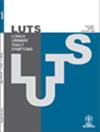Quality of Life After Augmentation Enterocystoplasty in Children
Abstract
Objectives
To evaluate outcomes following bladder augmentation in children at a specialized third-level center concerning quality of life (QoL), continence status, and sexual function.
Methods
The study population included bladder augmented patients treated over the last 25 years. We established contact with them and emailed an online survey with three validated questionnaires: QoL (EQ-5D-5L), incontinence (ICIQ-SF) and sexual function (FSH/FSM2).
Results
Twenty-four patients, aged between 9 and 44, answered the questionnaire. Among respondents, 54.2% declared experiencing some problem in one or more of the five evaluated dimensions. The mean EQ-VAS score was 80 out of 100, while the mean EQ-5D-5L index was 0,845 out of 1. Based on the ICIQ-SF questionnaire, 58.3% of patients were classified as incontinent. Regarding the bother scale (0–10), the mean score was 4.7 ± 3. Among the 18 patients old enough to answer the sexual function questionnaire, 11 (61.1%) described a low or nonexistent level of sexual satisfaction. Among the male cluster, the average score on the FSH questionnaire was 10.95 ± 6.78 (scale 2–24), while in the female cohort the average score on the FSM-2 questionnaire was 21.5 ± 9.64 (scale 2–32).
Conclusions
Despite the high complication rate and the presence of some degree of incontinence or sexual dysfunction in nearly 60% of patients undergoing bladder augmentation in childhood, our cohort exhibits relatively good QoL scores when compared to those reported for the general population.

 求助内容:
求助内容: 应助结果提醒方式:
应助结果提醒方式:


